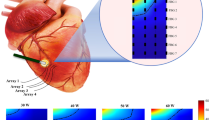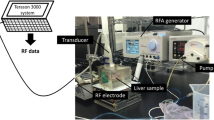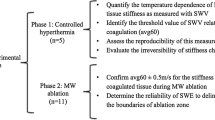Abstract
Purpose
We demonstrate a novel method for automatic direct lesion depth (LD) tracking during coagulation from time series of a single A-mode ultrasound (US) transducer custom fit at the tip of a RFA catheter. This method is named thermal expansion imaging (TEI).
Methods
A total of 35 porcine myocardium samples were ablated (LD 0.5–5 mm) while acquiring US, electrical impedance (EI) and contact force (CF) data. US images are generated in real time in terms of echo intensity (M-mode) and phase (TEI). For TEI, displacements between US time series are estimated with time-domain cross-correlation. A modified least squares strain estimation with temporal and depth smoothing reveals a thermal expansion boundary (TEB)—negative zero-crossing of temporal strain—which is associated to the coagulated tissue front.
Results
M-mode does not reliably delineate RFA lesions. TEI images reveal a traceable TEB with RMSE \(=\) 0.50 mm and \(R^{2}=0.85\) with respect to visual observations. The conventional technique, EI, shows lower \(R^{2}=0.7\) and \(>\)200 % variations with CF. The discontinuous time progression of the TEB is qualitatively associated to tissue heterogeneity and CF variations, which are directly traceable with TEI. The speed of sound, measured in function of tissue temperature, increases up to a plateau at 55 \(^{\circ }\hbox {C}\), which does not explain the observed strain bands in the TEB.
Conclusions
TEI successfully tracks LD in in vitro experiments based on a single US transducer and is robust to catheter/tissue contact, ablation time and even tissue heterogeneity. The presence of a TEB suggests thermal expansion as the main strain mechanism during coagulation, accompanied by compression of the adjacent non-ablated tissue. The isolation of thermally induced displacements from in vivo motion is a matter of future research. TEI is potentially applicable to other treatments such as percutaneous RFA of liver and high-intensity focused ultrasound.









Similar content being viewed by others
References
De Luna AB (2012) Clinical electrocardiography: a textbook. Wiley, Chichester, UK
Kannel WB, Abbot RD, Savage DD, McNamara PM (1982) Epidemiologic features of chronic atrial fibrillation: the framingham study. N Engl J Med 306(17):1018–1022
Ostrander L, Brandt RL, Kjelsberg MO, Epstein FH (1965) Electrocardiographic findings among the adult population of a total natural community, tecumseh, michigan. Circulation 31(6):888–898
McRury ID, Haines DE (1996) Ablation for the treatment of arrhythmias. Proc IEEE 84(3):404–416
Haissaguerre M, Jais P, Shah DC (1998) Spontaneous initiatoin of atrial fibrillation by ectopic beats originating in the pulmonary veins. N Engl J Med 339:659–666
Haines DE (1993) The biophysics of radiofrequency catheter ablation in the heart: the importance of temperature monitoring. Pacing Clin Electrophysiol 16(3):586–591
Nath S, Lynch C, Whayne JG, Haines DE (1993) Cellular electrophysiological effects of hyperthermia on isolated guinea pig papillary muscle. Implications for catheter ablation. Circulation 88(4):1826–1831
Matsudaira K, Nakagawa H, Wittkampf FH, Yamanashi WS, Imai S, Pitha JV, Lazzara R, Jackman WM (2003) High incidence of thrombus formation without impedance rise during radiofrequency ablation using electrode temperature control. Pacing Clin Electrophysiol 26(5):1227–1237
Cappato R, Calkins H, Chen S-A (2010) Updated worldwide survey on the methods, efficacy, and safety of catheter ablation for human atrial fibrillation. Circ Arrhythm Electrophsiol 3:32–38
Shah D (2011) A critical appraisal of cardiac ablation technology for catheter-based treatment of atrial fibrillation. Expert Rev Med Devices 8(1):49–55
Haemmerich D (2010) Biophysics of radiofrequency ablation. Crit Rev Biomed Eng 38(1):53–63
Perez FJ, Wood MA, Schubert CM (2006) Effects of gap geometry on conduction through discontinuous radiofrequency lesions. Circulation 113:1723–1729
Okumura Y, Johnson SB, Bunch TJ, Henz BD, O’Brien CJ, Packer DL (2008) A systematical analysis of in vivo contact forces on virtual catheter tip/tissue surface contact during cardiac mapping and intervention. J Cardiovasc Electrophysiol 19(6):632–640
Blouin LT, Marcus FI, Lampe L (1991) Assessment of effects of a radiofrequency energy field and thermistor location in an electrode catheter on the accuracy of temperature measurement. Pacing Clin Electrophysiol 14(5):807–813
Chugh SS, Chan RC, Johnson SB, Packer DL (1999) Catheter tip orientation affects radiofrequency ablation lesion size in the canine left ventricle. Pacing Clin Electrophysiol 22(3):413–420
Lustgarten DL, Spector PS (2008) Ablation using irrigated radiofrequency: a hands-on guide. Heart Rythm 5(6):899–902
Shah DC, Lambert H, Nakagawa H, Lagenkamp A, Aeby N, Leo G (2010) Area under the real-time contact force curve (force-time integral) predicts radiofrequency lesion size in an in vitro contractile model. J Cardiovasc Electrophysiol 21(9):1038–1043
Yokoyama K, Nakagawa H, Shah DC, Lambert H, Giovanni L, Aeby N, Ikeda A, Pitha JV, Sharma T, Lazzara R, Jackman WM (2008) Novel contact force sensor incorporated in irrigated radiofrequency ablation catheter predicts lesion size and incidence of steam pop and thrombus/clinical perspective. Circ Arrhythm Electrophsiol 1(5):354–362
Betensky BP, Jauregui M, Campos B, Michele J, Marchlinski FE, Oley L, Wylie B, Robinson D, Gerstenfeld EP (2012) Use of a novel endoscopic catheter for direct visualization and ablation in an ovine model of chronic myocardial infarction. Circulation 126:2065–2072
Kolandaivelu A, Zviman MM, Castro V, Lardo AC, Berger RD, Halperin HR (2010) Non-invasive assessment of tissue heating during cardiac radiofrequency ablation using MRI thermography/clinical perspective. Circ Arrhythm Electrophsiol 3:521–529
Ranjan R, Koholmovski EG, Blauer J (2012) Identification and acute targeting of gaps in atrial ablation lesion sets using a real-time magnetic resonance imaging system. Circ Arrhythm Electrophsiol 5:1130–1135
Hoskins P, Martin K, Thrush A (2010) Diagnostic ultrasound: physics and equipment. Cambridge University Press, New York
Bush N, Rivens I, Ter Haar G, Bamber J (1993) Acoustic properties of lesions generated with an ultrasound therapy system. Ultrasound Med Biol 19(9):789–801
Hynynen K (1997) Review of ultrasound therapy. In: Proceedings IEEE ultrasonics symposium, pp 1305–1313
Maleke C, Konofagou EE (2008) Harmonic motion imaging for focused ultrasound: a fully integrated technique for sonification and monitoring of thermal ablation in tissues. Phys Med Biol 53(6):1773–1793
ter Haar G, Sinnett D, Rivens I (1995) Ultasound focal beam surgery. Ultrasound Med Biol 21(9):1089–1100
Kumon RE, Gudur MS, Zhou Y, Deng CX (2012) High-frequency ultrasound M-mode imaging for identifying lesion and bubble activity during high-intensity focused ultrasound ablation. Ultrasound Med Biol 38(4):626–641
Bunch TJ, Bruce GK, Johnson SB, Sarabanda A, Milton MA, Packer DL (2004) Analysis of catheter-tip (8-mm) and actual tissue temperatures achieved during radiofrequency ablation at the orifice of the pulmonary vein. Circulation 110(19):2988–2995
Wright M, Harks E, Deladi S, Suijver F, Barley M, van Dusschoten A, Fokkenrood S, Zuo F, Sacher F, Hocini M, Haïssaguerre M, Jäis P (2011) Real-time lesion assessment using a novel combined ultrasound and radiofrequency ablation catheter. Heart Rythm 8(2):304–312
Eyerly SA, Hsu SJ, Agashe SH, Trahey GE, Li Y, Wolf PD (2010) An in vitro assessment of acoustic radiation force impulse imaging for visualizing cardiac radiofrequency ablation lesions. J Cardiovasc Electrophysiol 21(5):557–563
Seo CH, Shi Y, Huang SW, Kim K, O’Donnell M (2011) Thermal strain imaging: a review. Interface Focus 1(4):649–664
Miller NR, Bamber JC, Ter Haar G (2004) Imaging of temperature-induced echo strain: preliminary in vitro study to assess feasibility for guiding focused ultrasound surgery. Ultrasound Med Biol 30(3):345–356
Varghese T, Zagzebski JA, Chen Q, Techavipoo U, Frank G, Johnson C, Wright A, Lee FT Jr (2002) Ultrasound monitoring of temperature change during radiofrequency ablation: preliminary in-vivo results. Ultrasound Med Biol 28(3):321–329
Seo CH, Stephens D, Cannata J, Dentinger A, Lin F, Park S, Wildes D, Thomenius KE, Chen P, Nguyen T, de La Rama A, Jeong JS, Mahajan A, Shivkumar K, Nikoozadeh A, Oralkan O, Truong U, Sahn DJ, Khuri-Yakub PT, O’Donnell M (2011) The feasibility of using thermal strain imaging to regulate energy delivery during intracardiac radio-frequency ablation. IEEE Trans Ultrason Ferroelectr Freq Control 58(7):1406–1417
Souchon R, Bouchoux G, Maciejko E, Lafon C, Cathignol D, Bertrand M, Chapelon JY (2005) Monitoring the formation of thermal lesions with heat-induced echo-strain imaging: a feasibility study. Ultrasound Med Biol 31(2):251–259
Baki PS (2014) Sensorized cardiac radiofrequency ablation system for lesion depth assessment. PhD Thesis, ETH Zurich
Baki PS, Szekely G, Kosa G (2013) Design and characterization of a novel, robust, tri-axial force sensor. Sensor Actuat A Phys 192:101–110
Cao H, Tungjitkusolmun S, Choi YB, Tsai J, Vorperian VR, Webster JG (2002) Using electrical impedance to predict catheter-endocardial contact during rf cardiac ablation. IEEE Trans Biomed Eng 49(3):247–253
Wittkampf FH, Hauer RN, de Medina ER (1989) Control of radiofrequency lesion size by power regulation. Circulation 80(4):962–968
Stephens DN, O’Donnell M, Thomenius K, Dentinger A, Wildes D, Chen P, Shung KK, Cannata J, Khuri-Yakub P, Oralkan O, Mahajan A, Shivkumar K, Sahn DJ (2009) Experimental studies with a 9f forward-looking intracardiac imaging and ablation catheter. J Ultrasound Med 28(2):207–215
Kallel F, Ophir J (1997) A least-squares strain estimator for elastography. Ultrasonic Imaging 19:195–208
Khurana I (2009) Textbook of medical physiology. Elsevier, Delhi
Lu J, Ying H, Sun Z, Motamedi M, Bell B, Sheppard L C (1996) In vitro measurement of speed of sound during coagulate tissue heating. In: Proceedings IEEE ultrasonics symposium, pp 1299–1302
Masugata H, Mizushige K, Senda S, Kinoshita A, Sakamoto H, Sakamoto S, Matsuo H (1999) Relationship between myocardial tissue density measured by microgravimetry and sound speed measured by acoustic microscopy. Ultrasound Med Biol 25(9):1459–1463
van Sonnenberg E, Livraghi T, Mueller PR, McMuller W, Golbiati L, Silverman SG (2008) Tumor ablation: principles and practice. Springer, New York
Livraghi T, Goldberg SN, Lazzaroni S, Meloni F, Solbiati L, Gazelle GS (1999) Small hepatocellular carcinoma: treatment with radio-frequency ablation versus ethanol injection. Radiology 210:655–661
Acknowledgments
This work was supported by the Swiss National Science Foundation (SNSF).
Conflict of interest
Peter Baki, Sergio J. Sanabria, Gabor Kosa, Gabor Szekely and Orcun Goksel declare that they have no conflict of interest.
Author information
Authors and Affiliations
Corresponding author
Rights and permissions
About this article
Cite this article
Baki, P., Sanabria, S.J., Kosa, G. et al. Thermal expansion imaging for monitoring lesion depth using M-mode ultrasound during cardiac RF ablation: in vitro study. Int J CARS 10, 681–693 (2015). https://doi.org/10.1007/s11548-015-1203-4
Received:
Accepted:
Published:
Issue Date:
DOI: https://doi.org/10.1007/s11548-015-1203-4




